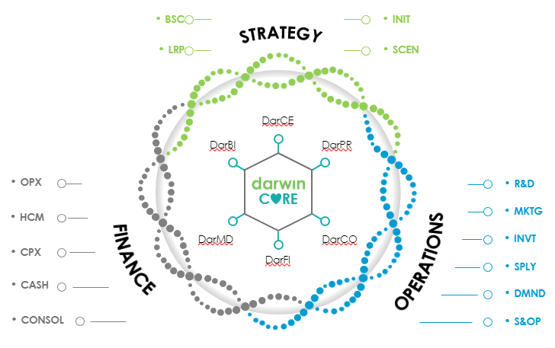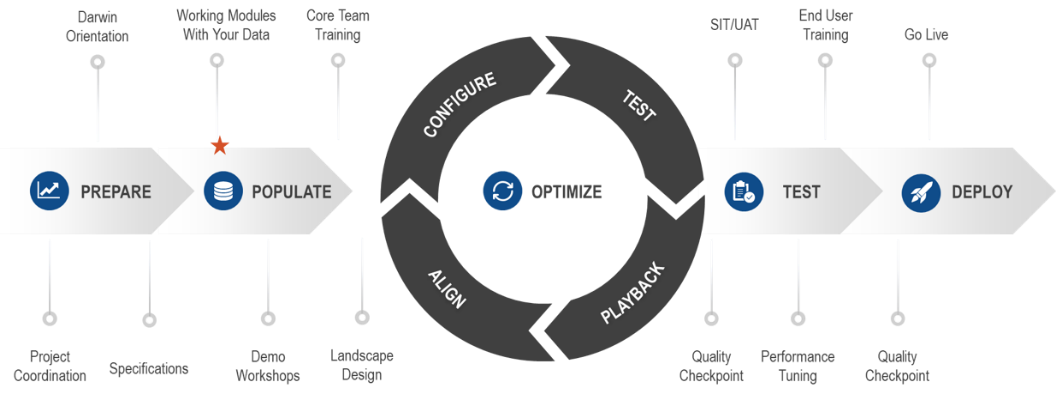SAP BPC Best Practices MEETS Prebuilt BPC Implementation Templates
THE PROBLEM |SAP Business Planning and Consolidation comes as a platform requiring you to build your application on your own. As you’re probably painfully aware, this typically takes your forever to finish…if ever, and leads to cost cutting, a slow system, and a one-off solution. In the end, your BPC implementation ends up not supportable beyond the original architect and doesn’t have any SAP BPC best practices baked in during rollout. The Darwin EPM suite was originally developed as a program within Column5, to incorporate the knowledge of 100’s of BPC implementations into prebuilt solution modules naturally fixing these problems while handling 80% of a typical user’s needs. Keep reading to see how this will work for you.
Over the years we saw that SAP Business Planning and Consolidation customers were facing three core implementation and support problems. Read on to see how we fix your three most common problems. Here they are:- BPC is NOT an Application: BPC, while very flexible and powerful, is a platform, not an application. Out of the box, there are no delivered planning templates, reports, dashboards, process flows, etc. While a blank slate is great for a seasoned user, users with prior training, or users with loads of time on their hands, this is not the case for most of us.
- You’re all Alone: When using a traditional approach, each SAP BPC implementation is a version 1.0. In other words, out of the box, BPC is a “blank canvas.” You’re both starting from scratch and continuing from there all by your lonesome. BPC requires expert design and technical skills to fully deploy. Most BPC users lack these skills which results in longer implementations, more testing and remediation, less functionality, and an inconsistent application of SAP BPC best practices. Building a BPC application from scratch provides maximum flexibility, but also maximum risk. In developing Darwin, we noticed a lot of instances where customers would implement BPC and have challenges in terms of scalability, performance, or usability. The costs associated with “doing it right” often caused them to cut corners in the name of cost efficiency, and this led to inadequate testing, less functionality, and best practices not being applied. Ultimately, we see clients that take this approach get less while spending more time. Finally, they rarely consider what’ll happen when the staff that builds the system leaves, which brings us to our 3rd problem.
- One of a Kind Solution: Congratulations, you have a custom SAP BPC implementation, so who’s going to support it three years later when staff has turned over? You have a one-off EPM solution that’s not supported outside of your organization. Outside training won’t help much because your system looks completely different. Also, who will support, maintain, and test your custom implementation when SAP releases new versions or replacement products? In short, your BPC system isn’t future proof.

THE SOLUTION | To combat the above problems, Column5 pulled together our most experienced consultants and decided to build Darwin EPM, an integrated suite of pre-built software modules within the different versions of BPC. Are you ready to finish building out your installation fast and avoid lousy performance even if you lack expert design and technical skills? See how below and solve the three problems above while you’re at it.
- Pre-built Templates: SAP BPC uses Microsoft Excel, and the SAP EPM Add-in. The native SAP EPM Add-in requires templates, layouts and basic workflows to be designed in Excel which is extremely time consuming. By comparison, Darwin EPM provides ready-to-go, professionally designed templates and workflows for each Darwin Module providing 80% of most users’ requirements out of the box – Fast and battle tested! Darwin also includes the Darwin EPM Ribbon for Excel which provides an intuitive interface users love to quickly access features from one spot.
- Don’t go it alone: Getting a good ROI from SAP BPC is hard enough and you’re busy. Why start from scratch or keep trying to implement by yourself when you can get the guaranteed, tested recipe? Why go thru all the trials we did when there’s pre-built modules like within Darwin EPM that reflect years of proven best practices from 100’s of implementations – your recipe, so to speak. Our consultants find that Darwin modules facilitate the most common use cases customers require, and the small remainder can be handled with Darwin’s customization.
- Build a standardized, supportable EPM System: Darwin EPM was developed by a team of EPM experts with extensive hands-on experience implementing 100’s of BPC systems so you’ll inherit all that best practice instantly through your Darwin modules. Using Darwin modules, you can follow a set installation and configuration sequence, providing a more standardized, supportable system when you’re done. Module functionality includes extensible data models, business logic and rules, business process flows, as well as input and report templates.
All the pre-built tools in each Darwin module are fully tested and supported across multiple BPC platforms. Documentation has gone through rigorous testing in terms of performance benchmarking and we also incorporate extensive usability testing and ongoing customer feedback to help make BPC easier to navigate and perform common tasks. All business rules are optimized for performance and scalability. We are committed to support the SAP BPC Roadmap and provide enhanced features, so you don’t have to worry about who’s going to support BPC thru inevitable change.
THE DARWIN PROGRAM |The functional perspective that SAP users love the most about Darwin EPM is to have pre-built templates, reports, logic, and process flows that addresses the full lifecycle of their Enterprise Performance Management system. They don’t have to recreate the wheel in any aspect of planning, from strategic to operational to financial. They get a common, centralized solution within SAP BPC.
"Darwin's interface was much more pleasing to our users, it doesn't look like a crude Excel experience, but more of an application."
- CTO, Global Sporting Goods Company
At the core is a calculation engine that makes sure that all rules are fully scalable and well performing, and that there is integration built in across each of the different components of a traditional planning environment. The idea is to deliver a tightly, integrated foundation for customers to support different types of planning, reporting and analytics requirements via a common set of business rules which function across modules. The Darwin calculation engine (DarCE) executes on the database layer, resulting in performance which is up to 95% faster than standard Logic Scripts, and provides a graphical user interface to help make the business rules easier to develop and maintain.

One of the key benefits we’ve seen repeatedly from customers who are taking advantage of Darwin EPM is the acceleration of the BPC implementation. It really does shift how BPC is implemented. Within a few weeks you can have working models with your data populated, and it becomes a more agile approach in which you are able to layer in additional functionality. It gives you a very advanced starting point for a foundation of your implementation and SAP BPC best practices.

MAIN FEATURES |There are several components that come as part of the platform:
- Darwin Calculation Engine (DarCE): provides the ability to render standard business calculations and logic definitions for all the Darwin EPM Planning Modules and enables additional calculations and logic to be defined for individual customers. It is a user interface to define and organize the business calculations and logic and manages the orchestration and execution of the calculations and logic on the SAP database tier of SAP BPC.
- Logging and audit tracking of the business calculations executions and status
- Enhanced navigation (Excel and Web): we have significantly enhanced the navigation across different components of your planning and reporting process.
- Management Reporting: integrated management reporting module which summarizes data from more detailed planning modules, such as Labor, OpEx, and Revenue
- Darwin Ribbon, which allows one-click navigation to input templates, reports, dashboards, and process flows
- Built-in dashboard framework
- Pre-built integration between Darwin Modules
"Darwin has exceeded our expectations, and our users are now excited to be engaged in the EPM process. A big change from our prior EPM experiences."
- CFO, Global Financial Services Company
SAP Business Planning and Consolidation is tough enough, don’t go it alone and suffer with half the functionality you need, a slow system, and no way to support it. Contact us today at ssussman@column5.com to get your free demo.
Want to know more about what Darwin EPM can do for your organization?











